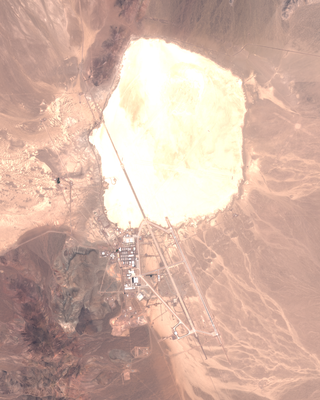
Area 51 is the common name of a highly classified United States Air Force (USAF) facility within the Nevada Test and Training Range. A remote detachment administered by Edwards Air Force Base, the facility is officially called Homey Airport or Groom Lake. Details of its operations are not made public, but the USAF says that it is an open training range, and it is commonly thought to support the development and testing of experimental aircraft and weapons systems. The USAF and CIA acquired the site in 1955, primarily for flight testing the Lockheed U-2 aircraft.
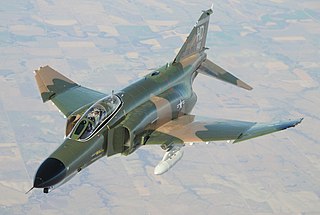
The McDonnell Douglas F-4 Phantom II is an American tandem two-seat, twin-engine, all-weather, long-range supersonic jet interceptor and fighter-bomber originally developed by McDonnell Aircraft for the United States Navy. Proving highly adaptable, it entered service with the Navy in 1961 before it was adopted by the United States Marine Corps and the United States Air Force, and by the mid-1960s it had become a major part of their air arms. Phantom production ran from 1958 to 1981 with a total of 5,195 aircraft built, making it the most produced American supersonic military aircraft in history, and cementing its position as a signature combat aircraft of the Cold War.

The Mikoyan-Gurevich MiG-21 is a supersonic jet fighter and interceptor aircraft, designed by the Mikoyan-Gurevich Design Bureau in the Soviet Union. Its nicknames include: "balalaika", because its planform resembles the stringed musical instrument of the same name; "Ołówek", Polish for "pencil", due to the shape of its fuselage, and "Én Bạc", meaning "silver swallow", in Vietnamese.

The Mikoyan-Gurevich MiG-17 is a high-subsonic fighter aircraft produced in the Soviet Union from 1952 and was operated by air forces internationally. The MiG-17 was license-built in China as the Shenyang J-5 and Poland as the PZL-Mielec Lim-6. The MiG-17 is still being used by the North Korean air force in the present day and has seen combat in the Middle East and Asia.
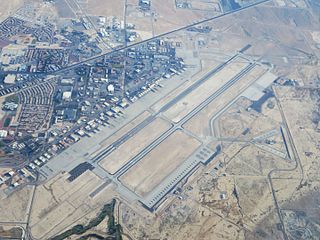
Nellis Air Force Base is a United States Air Force installation in southern Nevada. Nellis hosts air combat exercises such as Exercise Red Flag and close air support exercises such as Green Flag-West flown in "Military Operations Area (MOA) airspace", associated with the nearby Nevada Test and Training Range (NTTR). The base also has the Combined Air and Space Operations Center-Nellis.
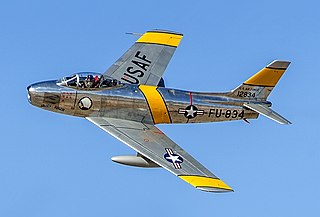
The North American F-86 Sabre, sometimes called the Sabrejet, is a transonic jet fighter aircraft. Produced by North American Aviation, the Sabre is best known as the United States' first swept-wing fighter that could counter the swept-wing Soviet MiG-15 in high-speed dogfights in the skies of the Korean War (1950–1953), fighting some of the earliest jet-to-jet battles in history. Considered one of the best and most important fighter aircraft in that war, the F-86 is also rated highly in comparison with fighters of other eras. Although it was developed in the late 1940s and was outdated by the end of the 1950s, the Sabre proved versatile and adaptable and continued as a front-line fighter in numerous air forces.
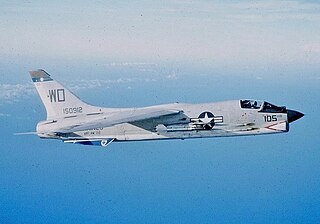
The Vought F-8 Crusader is a single-engine, supersonic, carrier-based air superiority jet aircraft designed and produced by the American aircraft manufacturer Vought. It was the last American fighter that had guns as the primary weapon, earning it the title "The Last of the Gunfighters".
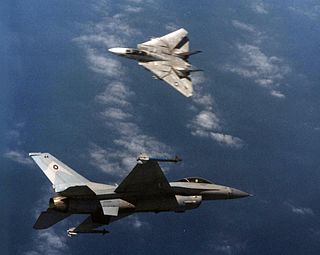
A dogfight, or dog fight, is an aerial battle between fighter aircraft conducted at close range. Modern terminology for air-to-air combat is air combat manoeuvring (ACM), which refers to tactical situations requiring the use of individual basic fighter maneuvers (BFM) to attack or evade one or more opponents. This differs from aerial warfare, which deals with the strategy involved in planning and executing various missions.
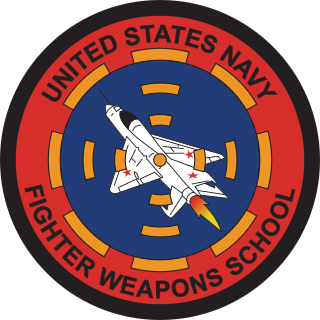
The United States Navy Strike Fighter Tactics Instructor program, more popularly known as Top Gun, is a United States Navy training program that teaches air combat maneuvering tactics and techniques to selected naval aviators and naval flight officers, who return to their operating units as surrogate instructors.

An aggressor squadron or adversary squadron is a squadron that is trained to act as an opposing force in military wargames. Aggressor squadrons use enemy tactics, techniques, and procedures to give a realistic simulation of air combat. Since it is impractical to use actual enemy aircraft and equipment, surrogate aircraft are used to emulate potential adversaries.

William Patrick "Willy Irish" Driscoll is a retired commander in the United States Navy and a flying ace. Driscoll, a Naval Flight Officer, and aircrewmate Duke Cunningham, a Naval Aviator, were their service's only aces of the Vietnam War. They remain the Navy's most recently minted aces.

Tonopah Test Range Airport, at the Tonopah Test Range is 27 NM southeast of Tonopah, Nevada, and 140 mi (230 km) northwest of Las Vegas, Nevada. It is a major airfield with a 12,000 ft × 150 ft runway, instrument approach facilities, and nighttime illumination. The facility has over fifty hangars and an extensive support infrastructure.

Brigadier General Richard Stephen Ritchie served as an officer in the United States Air Force and the Colorado Air National Guard, and a general officer in the Air Force Reserve. Ritchie joined Navy Commander Randy Cunningham as the only two pilots among the five American aces during the Vietnam War. Ritchie is a recipient of the Air Force Cross, the second highest military decoration that can be awarded to a member of the United States Air Force.
VFAX for Naval Fighter Attack Experimental was actually two specifications for two US Navy fighter projects. The first was for a low cost lightweight complement for the General Dynamics–Grumman F-111B which could replace the McDonnell F-4 Phantom II for air superiority, escort, and ground attack missions in the early 1960s. This role was dropped in favor of the VFX aircraft, which emerged as the F-14 Tomcat. The second VFAX evolved when the VFX proved too costly to replace all existing USN fighters and attack aircraft, and the Navy was invited to take part in the USAFs Lightweight Fighter Program (LWF). The Navy chose the YF-17, the loser of the LWF contest as its Navy Air Combat Fighter, as it was inherently more suitable to naval operations than the winning General Dynamics F-16 Fighting Falcon; it was redesigned to become the McDonnell Douglas F/A-18 Hornet.

Dissimilar air combat training (DACT) was introduced as a formal part of US air combat training after disappointing aerial combat exchange rates in the Vietnam War.
The Fighter Mafia was a controversial group of United States Air Force officers and civilian defense analysts who, in the 1960s and 1970s, advocated for fighter design criteria in opposition to those of the design boards of the time, and the use of John Boyd and Thomas P. Christie's energy-maneuverability (E-M) theory in designing fighter aircraft. The Mafia influenced the specifications for the F-X Program and went on to independently develop specifications for the Light Weight Fighter (LWF). Mafia member Harry Hillaker designed the purely air superiority day fighter prototype YF-16, which won the LWF contest but then turned into the multi-role fighter-bomber F-16 Fighting Falcon. The group's nickname, a professional jest coined by Everest Riccioni, an Air Force member of Italian heritage, was a rejoinder to the "Bomber Mafia".
The Thanh Hóa Bridge, spanning the Song Ma river, is situated 3 miles (4.8 km) northeast of Thanh Hóa, the capital of Thanh Hóa Province in Vietnam. The Vietnamese gave it the nickname Hàm Rồng. In 1965 during the Vietnam War, it was the objective of many attacks by US Air Force and US Navy aircraft which would fail to destroy the bridge until 1972, even after hundreds of attacks. The bridge was restored in 1973. As of 2016, the bridge still stands.

Colonel Charles Barbin DeBellevue is a retired officer in the United States Air Force (USAF). In 1972, DeBellevue became one of only five Americans to achieve flying ace status during the Vietnam War, and the first as a USAF Weapon Systems Officer (WSO), an integral part of two-man aircrews with the emergence of air-to-air missiles as the primary weapons during aerial combat. He was credited with a total of six MiG kills, the most earned by any U.S. aviator during the Vietnam War, and is a recipient of the Air Force Cross.

Have Doughnut was the name of a Defense Intelligence Agency project whose purpose was to evaluate and exploit a MiG-21 "Fishbed-E" that the United States Air Force acquired in 1967 from Israel. Israel acquired the aircraft as the result of its Operation Diamond when, on August 16, 1966, Iraqi Air Force pilot Capt. Munir Redfa, in a defection pre-arranged by the Israeli Mossad intelligence agency, flew it to Israel during a training flight.
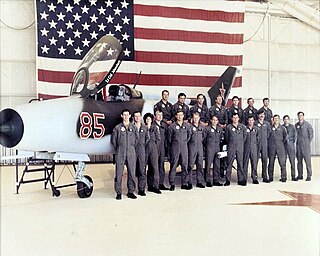
The 4477th Test and Evaluation Squadron was a squadron in the United States Air Force under the claimancy of the Tactical Air Command (TAC). It is currently inactive. The product of Project Constant Peg, the unit was created to expose the tactical air forces to the flight characteristics of fighter aircraft used by the Soviet Union during the Cold War. The declassified history of the squadron shows that it operated MiG-17s, MiG-21s and MiG-23s between 1977 and 1988, but it was not formally disbanded until July 1990.

















